A 16-inch mattress isn’t just about height—it’s a strategic choice for those prioritizing long-term comfort and support. Unlike thinner options, this thickness is likely to combine multiple layers of advanced materials. It creates a sleep surface that adapts to your body while maintaining structural integrity. Let’s explore why it’s becoming a go-to for sleepers seeking a balance between plushness and stability!
Ample Support and Comfort
When it comes to firm mattresses, a 16-inch design stands out. The extra depth allows manufacturers to incorporate dense support cores, like pocketed springs or firm memory foam, paired with softer top layers, such as cooling gel memory foam. This combination ensures your spine stays aligned whether you’re a back sleeper or prefer curling up on your side. For those needing extra firm options, thicker mattresses often include reinforced edge support to prevent sagging.
Consider this: a 16-inch mattress typically includes three distinct zones. The base layer provides foundational stability, while middle layers regulate pressure distribution. The top layer—often infused with cooling gel, graphite, copper, or made of air cell memory foam—offers contouring comfort. This multi-tiered approach caters to diverse needs, from athletes recovering from workouts to individuals managing chronic pain.
Ideal for All Sleep Positions
Your sleep position dictates everything from neck alignment to hip support. A 16-inch mattress accommodates side, back, and stomach sleepers through intelligent layering. Side sleepers may benefit from plush pillow top sections that cushion shoulders and hips. Back sleepers get lumbar support from hybrid mattresses combining coils and foam. Stomach sleepers? The extra firm base layers keep their spine neutral.
Hybrid models excel here. Imagine a 16-inch king size mattress with memory foam and spring layers: the coils respond to movement, while the foam minimizes motion transfer. This setup works whether you’re solo on a twin XL or sharing a queen size mattress. Plus, thicker profiles often include euro top or medium pillow top designs, adding versatility for combination sleepers who shift positions nightly.
Enhanced Durability
Thicker mattresses are likely to outlast slimmer models. A 16-inch structure uses high-density foams and wrapped coil systems that resist wear. For instance, innerspring mattress designs with reinforced edges can handle years of use without developing dips. Hybrids with pocket coils and gel foam mattress layers also maintain shape better than all-foam versions under 12 inches.
Durability isn’t just about materials—it’s about design. Many 16-inch firm mattresses include premier rest technologies like reinforced borders or dual-layer coil systems. These features prevent the “roll-off” effect common in thinner beds. Pair it with a mattress pad for added protection, and you’ve got a sleep surface built to last a decade or more.
Key Features to Look For
Not all 16-inch mattresses are equal. Prioritize these elements when shopping:
- Cooling: Look for cooling gel memory foam or other memory foam mattress layers designed to regulate temperature and improve airflow
- Layered Support: Combine extra-firm base foams with medium-firm transition layers
- Edge Reinforcement: Essential for king-size mattresses or queen-size beds used by couples, it ensure you don’t fall off when sleeping closer to the edge.
- Certifications: CertiPUR-US® foams ensure low VOC emissions. OekoTex® covers are safer for the skin.
If you’re debating between foam mattresses and hybrids, consider sleep habits. Pure memory foam suits those who want maximum contouring, while spring hybrid mattress designs better support active sleepers and couples. For hot sleepers, models with cooling technology or breathable euro top surfaces prevent night sweats.
Who Benefits Most from a 16-Inch Mattress?
Three groups find these mattresses transformative:
- Combination Sleepers: The varied layers adapt quickly as you shift from back to side positions
- Plus-Sized Individuals: Extra thickness prevents bottoming out, offering consistent support
- Chronic Pain Sufferers: Zoned support in 16-inch hybrid mattresses alleviates pressure on joints
Let’s address a common concern: Is a 16-inch mattress too tall? Standard bed frames work fine. Box springs may be a challenge. If you can’t find low-profile box springs, you’ll likely be better off with a thinner mattress. For adjustable bases, ensure the mattress is compatible and the bed can support its weight — most hybrids and inch gel memory foam models are flexible enough. You surely won’t be able to use a 16” mattress for Murphy beds and trundle beds, as they usually accommodate mattress heights of up to 12”.
Material Breakdown
Understanding layers is crucial. A typical 16-inch build includes:
- Base Layer (4-6″): High-density foam or pocket coils for foundational support
- Transition Layer (3-4″): Medium firm polyfoam or microcoils
- Comfort Layer (2-3″): Cooling gel memory foam mattress or latex
- Top Layer (1-2″): Plush euro pillow top or quilted cover
This construction explains why 16-inch mattresses outperform thinner models. The separation of support and comfort functions allows each layer to specialize. For example, the firm memory foam mattress base won’t soften prematurely, while the contouring comfort layer molds to your curves without collapsing. Of course, some brands embed more layers and go the extra mile with their support layers, giving them an ergonomic design or profiling several comfort zones.
Making the Right Choice
Test these factors when selecting your mattress:
- Edge Support: Sit on the bed’s edge—it shouldn’t compress more than 30%
- Motion Isolation: Place a glass of water on one side and press nearby—minimal ripples mean good isolation
- Temperature Control: Feel for cool memory foam technologies if you sleep hot
Remember that thickness alone doesn’t guarantee quality. A well-made 12-inch mattress with premium materials could outperform a cheaply made 16-inch model. Focus on layer composition and density ratings (aim for ≥1.8 PCF for foams). For extra firm preferences, look for ILD ratings above 12 in comfort layers.
When upgrading from a traditional innerspring mattress, give your body 2-3 weeks to adjust to the new support profile. Many 16-inch models, especially hybrid cooling types, feel firmer initially before conforming to your shape.
Finally, consider your bed’s ecosystem. A 16-inch king mattress pairs well with sturdy frames like the Indestruct Bed, while twin XL sizes might need center support legs. Use a mattress topper only if you need minor adjustments—thick mattresses shouldn’t require one for basic comfort.
Key Features to Look for in a 16-Inch Mattress
Materials and Construction
What separates a premium 16-inch mattress from thinner models? It starts with the layers. Thicker profiles allow manufacturers to combine advanced materials that address support, cooling, and longevity in ways shorter beds can’t match. Let’s break down the essentials.
Memory Foam and Gel Infusions
High-density firm memory foam forms the backbone of many 16-inch designs. This base layer prevents sagging, especially in king-size or queen-size mattresses where weight distribution matters. But foam alone isn’t enough—that’s where cooling gel memory foam enters the picture. By infusing gel particles into the foam, manufacturers create a sleep surface that pulls heat away from your body.
Here’s why it works: gel conducts heat 25% faster than standard foam. In a 16-inch gel memory foam mattress, this technology prevents the “oven effect” common in cheaper all-foam beds. Pair it with breathable covers, and you’ve got a system that stays cool even during summer heatwaves.
Pocketed Springs for Support
While foam dominates many 16-inch builds, some people still love their springs. Pocketed springs remain a game-changer. Each coil moves independently, contouring to your body without disturbing your partner. In hybrid mattresses, these springs sit beneath foam layers, creating a responsive yet cushioned feel. For heavier individuals or king-size mattress users, pocket coils prevent premature sagging better than traditional innersprings.
Consider this: a 16-inch hybrid mattress with pocketed springs typically uses 15-gauge coils for durability. Thicker 12-gauge coils appear in extra firm models designed for plus-sized sleepers. Either way, the separation between coils reduces motion transfer—a must if you share a queen-size bed.
Comfort and Firmness Levels
Firmness isn’t one-size-fits-all. A 16-inch mattress’s height allows for precise tuning across multiple layers, catering to everyone from side sleepers needing pressure relief to stomach sleepers requiring rigid support.
Medium Firm to Extra Firm Options
Most 16-inch models land between medium firm (5-7 on the firmness scale) and extra firm (8-10). The secret lies in layer sequencing. A firm memory foam mattress might place dense base foam below a medium pillow top, while hybrids often pair coils with cooling gel memory foam for balanced support.
Back sleepers thrive on medium firm setups that keep spines neutral without feeling rigid. Stomach sleepers? They’ll want the unwavering support of an extra firm base layer. Many 16-inch designs solve this through zoned support—softer foam at the shoulders, firmer under the hips.
Temperature Regulation Features
Heat retention plagues many thick mattresses, but smart material choices solve this. Beyond cooling gel memory foam, look for:
- Phase-change fabrics in covers
- Perforated latex layers
- Airflow channels in pocketed springs systems
In hybrid cooling models, copper-infused foam draws heat away while moisture-wicking covers add another cooling layer. The result? A 16-inch gel memory foam mattress that sleeps 2-3°F cooler than traditional memory foam.
Construction Deep Dive
Let’s peel back the layers of a typical 16-inch build:
- Base (6”): High-density firm memory foam or pocketed springs
- Transition (4”): Medium firm polyfoam or microcoils
- Comfort (3”): Cooling gel memory foam with euro pillow top
- Surface (2”): Quilted cover with cooling fibers
This stack creates what engineers call “progressive support”— each layer responds differently to weight and pressure. When you lie down, the cooling green tea memory foam conforms instantly, while the pocketed springs beneath adjust to your movements. It’s why many hybrid mattresses outperform all-foam or all-spring designs.
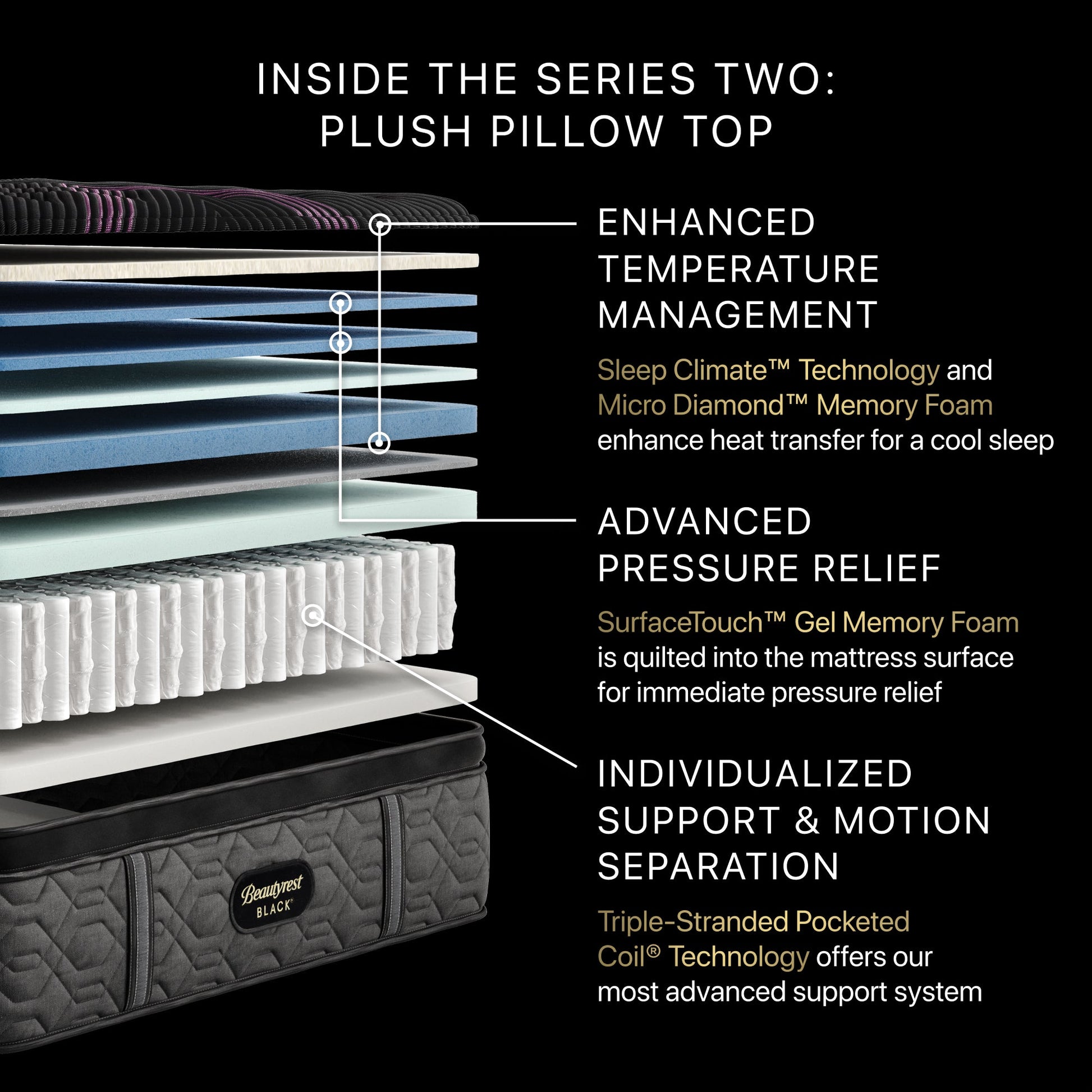
Real-World Testing Tips
Before committing to a 16-inch mattress, try these tests:
- Edge Support: Sit on the bed’s edge—if it collapses more than 4 inches, it lacks proper reinforcement
- Heat Test: Place your hand on the surface for 60 seconds—quality cooling gel memory foam should feel neutral, not warm
- Motion Transfer: Have a partner roll over—minimal disturbance means good pocketed springs isolation
Remember, thickness doesn’t guarantee quality. A well-made 12-inch firm memory foam mattress with CertiPUR-US® certified foam often outperforms a poorly constructed 16-inch model. Always check material densities—aim for ≥1.8 PCF in foam layers and ≥15-gauge coils in spring systems.
Sizing Considerations
While 16-inch mattresses work in most frames, note these details:
- King/Queen Size: Ensure your bed frame has center support legs
- Twin XL: Ideal for tall single sleepers needing extra legroom
- Adjustable Bases: Verify compatibility—some extra firm models resist bending
Pair your mattress with a low-profile box spring or platform bed. Avoid thick mattress pads—they can negate the contouring comfort of the top foam layers. For temperature-sensitive sleepers, consider a cooling gel mattress protector instead.
Mastering these features transforms mattress shopping from guesswork to precision. Whether you prioritize the pressure relief of cooling gel memory foam or the responsive support of pocketed springs, a 16-inch mattress adapts to your needs like no thinner bed can. The right combination of materials and firmness doesn’t just improve sleep—it redefines what rest feels like.
Tips for Finding the Best 16-Inch Mattress
Assessing Your Sleep Needs
Your sleep position dictates everything when choosing a mattress, no matter if it’s a 16” mattress or a different thickness. Side sleepers often need softer top layers to cushion shoulders and hips, while stomach sleepers require extra firm support to keep spines neutral. Back sleepers? A medium firm hybrid with pocket coils and cooling gel memory foam usually hits the sweet spot. Start by observing your nightly habits—do you sprawl out on a king-size bed or curl up on a twin XL?
Identifying Preferred Sleep Position
Grab a notebook. For three nights, jot down how you wake up. If you’re sideways 80% of the time, prioritize contouring comfort in the mattress’s top layers. Combination sleepers flipping between positions need responsive materials like hybrid mattresses with memory foam and spring systems. Remember: your dominant sleep position determines whether you’ll thrive on a plush pillow top or euro top medium-firm design.
Considering Back and Joint Support
Chronic pain demands strategic layering. A 16-inch gel memory foam mattress with zoned support targets pressure points better than uniform designs. For lower back issues, look for reinforced lumbar sections in queen-size mattresses. Arthritis sufferers often benefit from hybrid cooling models that combine gentle cushioning with temperature regulation.
Comparing Mattress Brands and Models
With over 150 U.S. mattress brands touting “best-in-class” designs, cutting through the noise requires strategy. Focus on verified performance metrics rather than marketing claims. The same mattress might excel in edge support but falter in motion isolation — know your non-negotiables before comparing.
Reading Customer Reviews
Skip the five-star fluff. Dig into reviews mentioning mattress sizes and long-term use. Phrases like “sagged after six months” or “stayed cool in summer” reveal more than overall ratings. For 16-inch hybrid mattresses, check if owners praise the pocketed springs’ durability. Be wary of reviews stating, “too firm” or “runs hot”—these signal potential mismatches with your sleep position needs.
Testing in Store
Nothing replaces hands-on testing. Visit a showroom and spend 15+ minutes on each contender. For queen-size mattresses, check edge support by sitting near the perimeter. Notice how cooling gel memory foam models feel after five minutes — do they trap heat or dissipate it? Ask about trial periods; many brands offer 100+ nights to test at home.
Size Matters—But So Does Space
While mattress sizes like split king or twin XL dominate spec sheets, measure your bedroom first. A 16-inch king-size mattress needs at least 76×80 inches of floor space—plus clearance for nightstands. Studio dwellers might opt for a full mattress with vertical storage solutions. Remember: thicker profiles demand compatible foundations. Verify your bed frame works with 16-inch heights—some platform beds require modifications.
The Price-Performance Sweet Spot
Premium doesn’t always mean better. A $1,200 hybrid cooling mattress with gel foam mattress layers often outperforms $3,000 luxury models. Set a budget range early, then compare features within it. For under $1,000, you’ll find solid options like the SweetNight CoolNest — its cooling gel memory foam and pocketed springs deliver hotel-quality support without the markup. Always cross-check warranties; reputable brands offer 10+ years on 16-inch mattresses.
When to Upgrade Your Foundation
Your old box springs might not cut it. Thick mattresses need sturdy bases—check manufacturer guidelines. Adjustable bases require compatibility with extra firm designs; some innerspring mattress models resist bending. For mattress sizes above queen, consider reinforced center legs. Pairing a 16-inch gel memory foam mattress with the wrong foundation voids warranties and accelerates wear.
Accessories that Enhance Performance
A thin mattress pad protects without compromising feel. Avoid thick toppers—they mask the contouring comfort of your mattress’s top layers. For hot sleepers, bamboo-derived protectors boost airflow in hybrid mattresses. If noise bothers you, felt padding between the mattress and base dampens pocketed springs’ creaks.
Choosing a 16-inch mattress isn’t about finding the thickest option—it’s about matching engineering to biology. Whether you prioritize the pressure relief of cooling gel memory foam or the bounce of hybrid mattresses, let your body’s signals guide the process. Test thoroughly, compare smartly, and remember: the right bed doesn’t just improve sleep—it transforms how you live awake.
From $500+ to $5000+ – The Price of a 16” Mattress?
A high-quality 16” mattress that meets all the above criteria costs around anywhere from $3000 to $5000. The perfect examples are the Black® Series Two Pillow Top models from Beautyrest and the Stearns & Foster Reserve® 16″ Mattresses. These brands are synonymous with quality and comfort, and their products are a dream for any sleeper.
With their luxurious tops, multiple cooling layers, and pocketed coils, their 16” mattresses will definitely help sleepers sleep undisturbed throughout the night. Other brands, like Puffy and their Monarch Mattress, take sleep and comfort to the next level with premium materials like Alpaca Wool and innovative technologies like the Elite 3D Cloud Matrix.
Unfortunately, not everyone can afford to spend $3000 or $5000 on a mattress, even with the various financing options available. If you want the benefits of a 16-inch mattress without the usual price tags, the SweetNight CoolNest Mattress will not disappoint you.
For its insanely affordable price, currently of only $539.99 / 16” queen, it ticks all the right boxes: cooling, breathability, pressure relief, support, motion isolation. It embeds patented materials following an intriguing, well-thought-out design, and is backed by a 100-night trial and a one-decade warranty.
Sure, it could do better on edge support, and I wish it had firmer and softer options and, why not, a pillowtop hybrid alternative. If these shortcomings are deal-breakers for you, I advise you to keep looking. But if you can live with them to spend 6 – 10 times less than you would on the above-mentioned higher-end alternatives, then the SweetNight CoolNest mattress won’t disappoint you.
Learn More About SweetNight and Their 16” CoolNest Mattress Here!




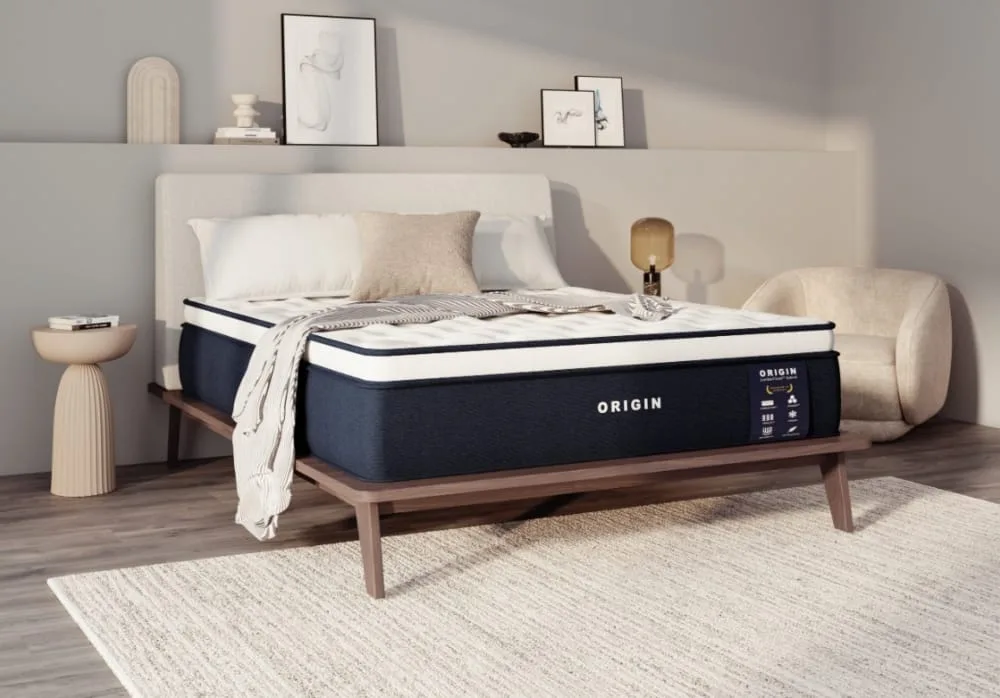



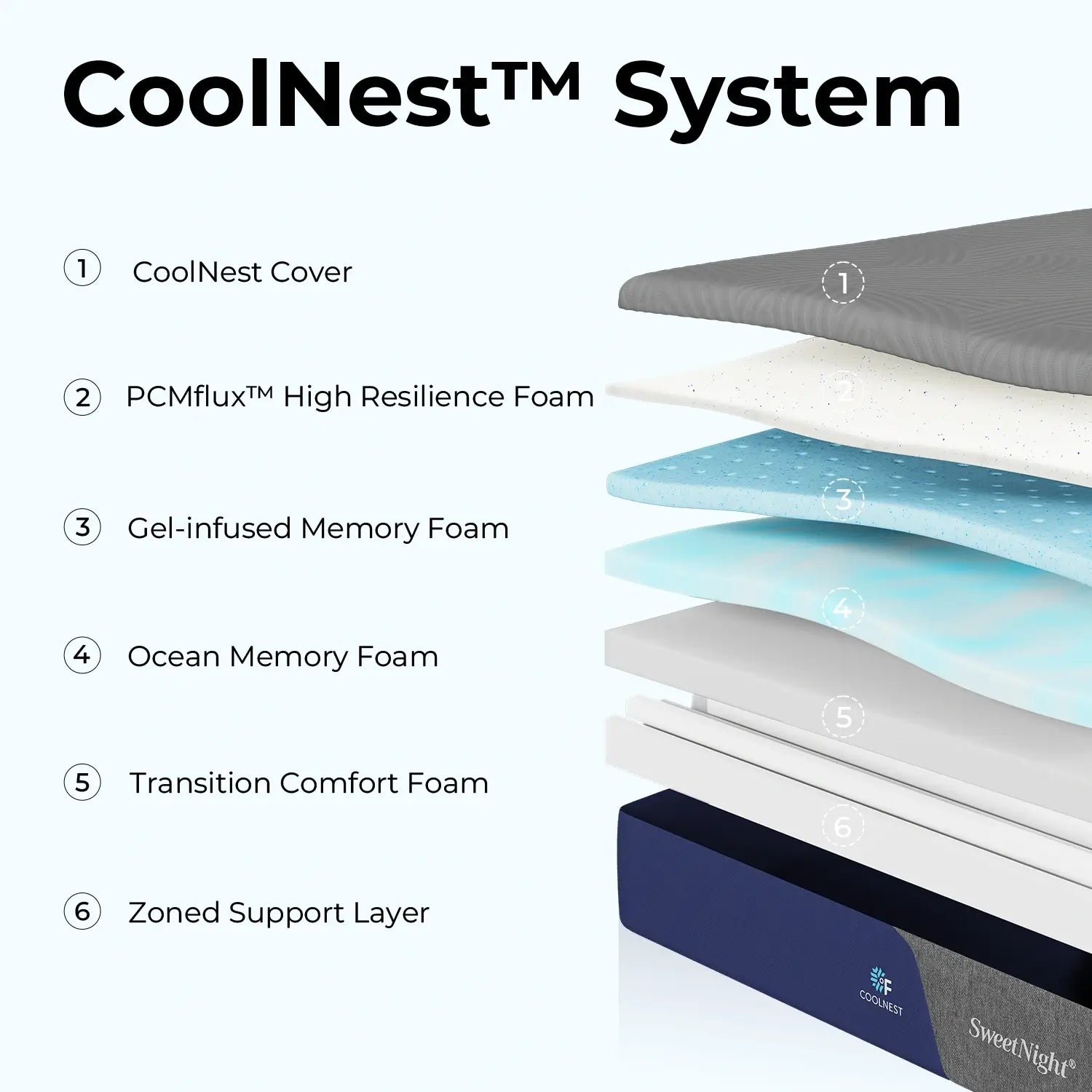
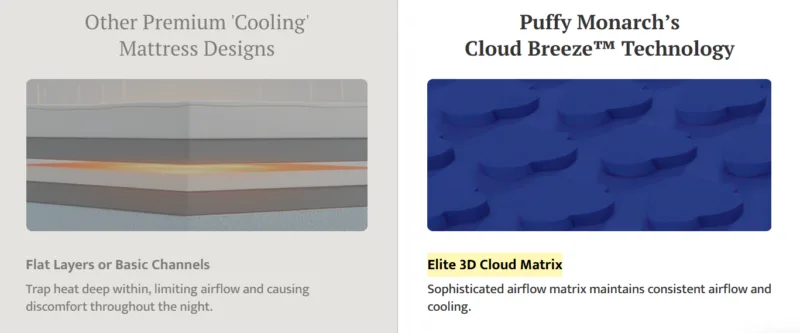
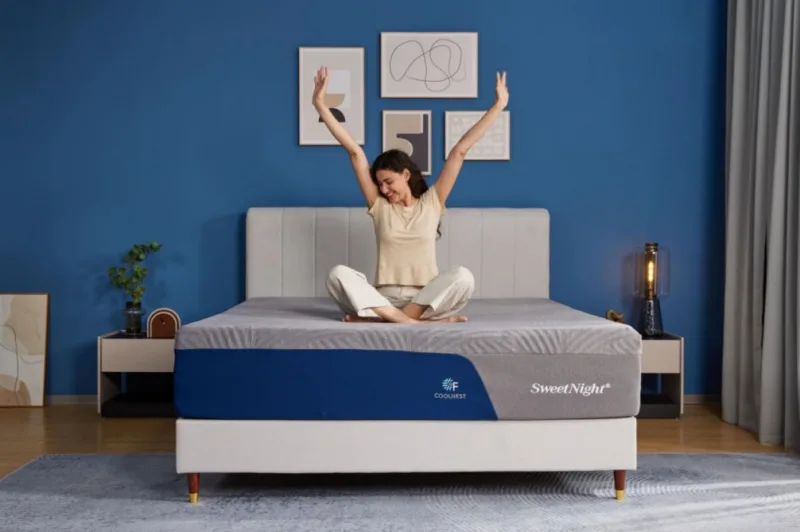



Leave a Reply
View Comments